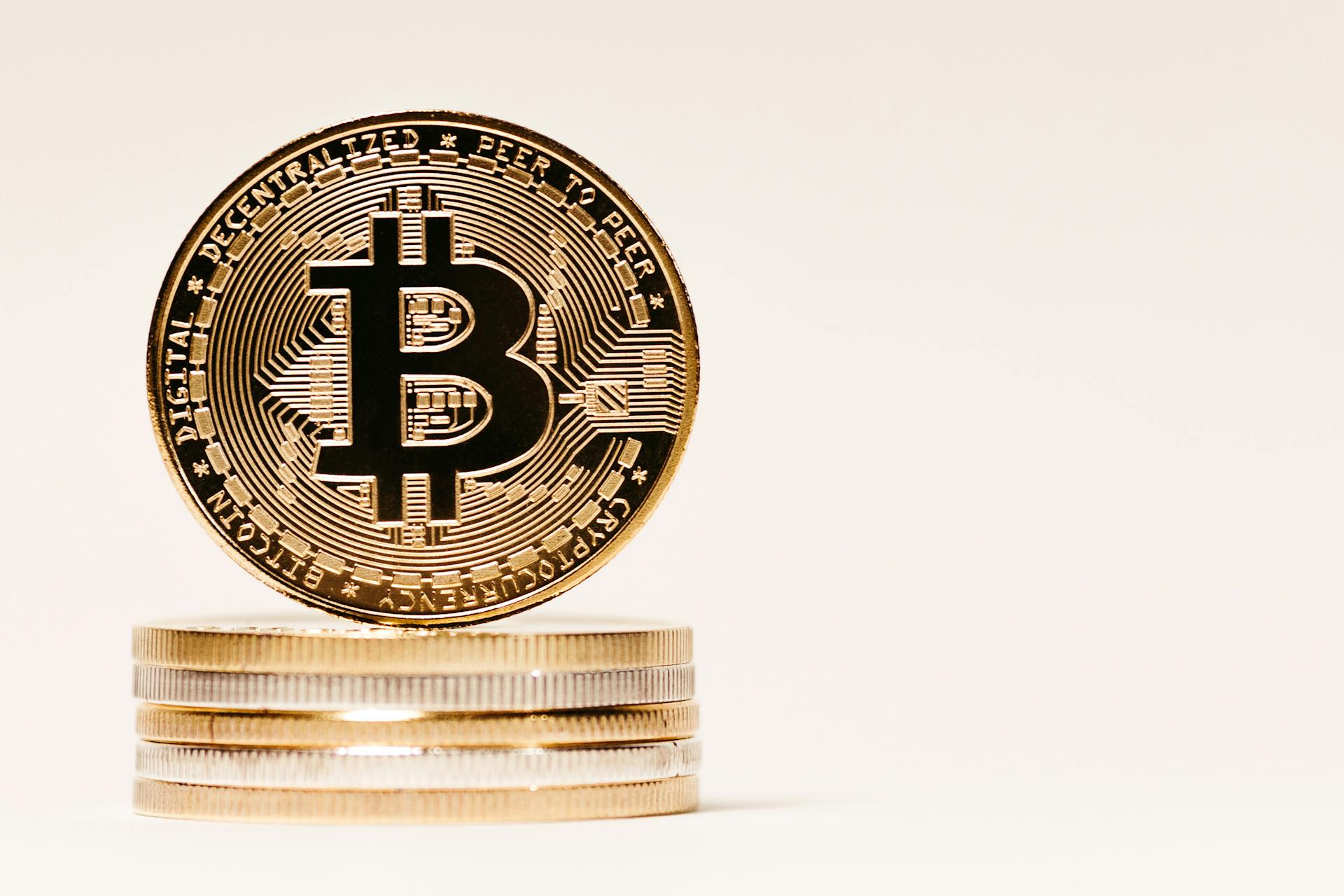
Fintech peer to peer lending is revolutionizing the way we borrow and lend money. It allows individuals to lend and borrow money directly, cutting out traditional financial institutions and reducing costs.
This model has gained popularity in recent years, with platforms like Lending Club and Prosper leading the way. By 2019, the global peer-to-peer lending market had grown to $140 billion.
One of the key benefits of fintech peer to peer lending is the potential for higher returns on investment. Borrowers can access funds at lower interest rates, while lenders can earn interest on their investments.
However, there are also challenges to consider, such as credit risk and regulatory hurdles. For example, the US Securities and Exchange Commission (SEC) has strict guidelines for peer-to-peer lending platforms.
What Is It and How Does It Work?
Fintech peer to peer lending is a game-changer for borrowers and lenders alike. It allows for direct loans between individuals, bypassing traditional banking systems.
This innovative approach has made it possible for people with limited credit history or collateral to access credit. The data-driven approach of fintech platforms ensures a more accurate assessment of risk, leading to fairer interest rates.
P2P lending apps serve as digital platforms that connect borrowers and lenders directly. They present a streamlined alternative to conventional lending, catering to a wider range of participants.
Here's a step-by-step breakdown of how a P2P lending application works:
- Borrowers sign up and submit essential details on the platform.
- Borrowers detail their loan needs, including the amount and purpose.
- The platform performs credit evaluations on borrowers, assigning a risk category or score to guide lenders.
- Lenders analyze available loans, deciding which ones to finance.
- Interest rates can be determined based on the borrower’s risk profile or via a bidding process among lenders.
- Borrowers adhere to the repayment schedule, which usually encompasses both the principal and interest.
- Lenders obtain repayments in line with their contribution, though the platform might subtract a service fee.
- In the event of loan defaults, the P2P platform manages the situation.
This process empowers lenders to directly participate in the lending market, diversifying their investment portfolio and contributing to a sense of financial inclusion and community empowerment.
Geographic Presence
The peer-to-peer lending industry has a significant presence in the United Kingdom, where Zopa, founded in 2005, was the first peer-to-peer lending company.
In the US, the industry started in 2006 with the launch of Prosper Marketplace and LendingClub. These two platforms were headquartered in San Francisco, California.
The UK government invested £20 million into British businesses via peer-to-peer lenders in 2012, and a second investment of £40 million was announced in 2014. This action was criticized for creating unfair competition in the UK.
By January 2017, 17 P2P providers were approved to offer the Innovative Finance Individual Savings Account (IFISA) in the UK, which qualified investments for tax advantages.
Suggestion: Mortgage Lending Industry
United States
The United States has a thriving peer-to-peer lending industry, which started in February 2006 with the launch of Prosper Marketplace.
Prosper and LendingClub are two of the pioneers in this space, both headquartered in San Francisco, California. Early peer-to-peer platforms had few restrictions on borrower eligibility, which led to adverse selection problems and high borrower default rates.
In 2008, the U.S. Securities and Exchange Commission (SEC) required peer-to-peer companies to register their offerings as securities, which was an arduous process. Prosper and LendingClub had to temporarily suspend offering new loans, while others, such as the U.K.-based Zopa Ltd., exited the U.S. market entirely.
Both LendingClub and Prosper gained approval from the SEC to offer investors notes backed by payments received on the loans, addressing the liquidity problem and making loan requests more transparent for lenders. The peer-to-peer companies are required to detail their offerings in a regularly updated prospectus, available to the public via EDGAR.
By 2013, LendingClub was the largest peer-to-peer lender in the US, followed by Prosper, with interest rates ranging from 5.6 to 35.8% and default rates varying from about 1.5% to 10% for riskier borrowers.
Broaden your view: Indian Bank Lending Rates
China
China has a vibrant P2P lending industry, with over 4,000 platforms operating in 2016, although 2,000 of them had already suspended operations.
Many of these platforms have struggled to stay afloat, with cash flow exceeding 191 billion Chinese Yuan (US$29 billion) in August 2016 alone.
A colloquial term for P2P lending in Chinese translates as "grey market", but is not to be confused with grey markets for goods or an underground economy.
In 2018, scores of Chinese online P2P lending platforms fell into financial or legal troubles due to tightened regulation and liquidity issues.
23 P2P platforms were reported to be in financial distress or under investigation in the first 10 days of July 2018, following 63 such cases in June.
Regulators have been cracking down on the industry, with the People's Bank of China announcing an extension of a nationwide campaign to clean up fraud and violations in the online financial market.
More than 5,000 operations have been shut down since the campaign began in 2016.
In April 2019, one of China's top peer-to-peer (P2P) lending platforms, tuandai.com, collapsed, resulting in financial losses for scores of Chinese investors.
Consider reading: Truth and Lending No down Payment on Car
Sweden

Sweden has a history of peer-to-peer lending, with Trustbuddy AB launching the first platform in 2007.
The platform provided a space for high-risk personal loans between 500SEK and 10,000SEK.
Brazil
In Brazil, p2p lending companies have been allowed to operate directly since April 2018.
The Central Bank of Brazil created a new type of institution called SEP, which stands for Sociedade de Emprestimo Pessoal, or personal lending society.
SEPs aim to provide a platform for direct negotiation of loans between individuals and companies.
A SEP cannot lend using its own resources but only operates as an intermediary.
Borrowers must be Brazilian individuals or companies, but there's no restriction on the nationality of lenders.
For your interest: Fintech Companies in India
Latvia
Latvia has a rapidly developing P2P lending market, with Q2 2018 seeing a total of Eur 271.8 million lent through P2P platforms and a cumulative total of Eur 1.7 billion.
The most active investors in Latvia's peer-to-peer lending platforms are residents of Germany, Great Britain, and Estonia.
Around nine companies that qualify as P2P investment platforms currently operate in Latvia.
Mintos, founded in 2015, has surpassed Eur 1 billion in total loans funded, with personal loans making up the majority of these loans.
You might enjoy: Predatory Lending Student Loans
Bulgaria
Bulgaria has a relatively small Peer-to-Peer lending market.
Currently, there is no specific regulation for Peer-to-Peer lending in Bulgaria.
Klear Lending is the only Bulgarian platform, launched in 2016.
It provides personal loans to prime customers.
The platform is operated by Klear Lending AD, a financial institution registered with the Bulgarian National Bank.
A unique perspective: Peer-to-peer Insurance
Advantages and Criticism
P2P lending offers a quick execution speed, making it an attractive option for borrowers who need fast access to funds.
Peer-to-peer lending solutions provide personalized financing options, allowing borrowers to choose the best loan terms for their needs.
On average, P2P lending interest rates range from 6% to 36%, which is often lower than traditional lending options.
This cost-effectiveness is one of the key reasons why people prefer P2P lending apps over traditional lending methods.
By applying for a loan from the comfort of their own homes, borrowers can save time and effort that would be spent on visiting banks or financial institutions.
The transparency and visibility into financial processes provided by P2P lending platforms also foster trust among users, allowing them to make more informed financial decisions.
Expand your knowledge: Lending Club Car Loan
Advantages and Criticism
One of the key advantages of P2P lending applications is their quick execution speed, which can finalize loans in a matter of hours or even less, compared to traditional banks where procedures can take days or weeks.
P2P lending platforms offer lower interest rates compared to traditional lending options, making them an attractive option for borrowers, with interest rates ranging from 6% to 36% on average.
Borrowers can apply for a loan from the comfort of their own homes, making it a convenient option. At the same time, lenders can invest their funds without incurring the high costs associated with traditional financial institutions.
P2P lending platforms provide clear and transparent information about terms, fees, and interest rates, removing any ambiguity in loan conditions and fostering trust within the lending platform.
The integration of technology in P2P loans has streamlined and made more convenient the disbursement and repayment processes, eliminating the need for cumbersome paperwork and in-person visits to banks.
Consider reading: Quicken Loans Predatory Lending
P2P lending solutions are more inclusive, catering to a diverse range of borrowers, including those with varied credit backgrounds, and broadening the scope of loan accessibility.
However, P2P lending applications also come with certain limitations, including reduced safeguarding, increased default risk, potential fee implications, and the lack of regulation and oversight.
Traditional P2P lending has given small and medium-sized businesses an alternative source of capital when faced with increasingly stringent bank regulations, and the volume of business and consumer peer-to-peer loans has seen a 30% increase since 2017.
Business Landscape Analysis
Analyzing the business landscape is essential for a successful P2P lending app. A well-conducted business analysis sets the stage for a strategic and informed entry into the market.
To understand the current business landscape, you need to conduct a detailed study of prevailing market trends. This involves identifying the most promising customer segments and understanding effective revenue models.
Examining the strategies of top competitors can help you spot potential market gaps and introduce your own unique vision. Such insights pinpoint areas of opportunity and help tailor the app's approach to deeply resonate with the intended audience.
By conducting a thorough business analysis, you can gain a deeper understanding of the market and make informed decisions about your P2P lending app.
You might like: Private Credit Markets
Increased Default Risk
Peer-to-peer lending platforms have a higher susceptibility to borrower defaults, posing challenges for lenders expecting consistent returns on their investments.
The default rate for loans originated by Prosper in 2007 was actually higher than projected, at 36.1%, with $46,671,123 of the $178,560,222 loaned out written off by investors, a loss rate of 26.1%.
Zopa's bad loan ratio was 0.84% of the £200m loaned out during its first seven years of lending history, while Funding Circle's bad debt level was 1.5% as of November 2013.
At the other end of the range, platforms like Bondora have default rates varying up to as high as 70+% for loans made to less credit-worthy customers.
This increased default risk is a key consideration for lenders, and it's essential to carefully evaluate the risk profile of any platform before investing.
Intriguing read: Private Lenders Online
Platforms and Solutions
APIs play a crucial role in developing P2P lending solutions, allowing for seamless integration of different systems and services. They enable the app to access data and functionalities from external sources, streamlining processes and improving the user experience.
Several useful APIs can be integrated into a P2P lending app, including payment gateway APIs, credit check APIs, KYC APIs, notifications APIs, and geolocation APIs. These APIs can significantly enhance the functionality of your P2P lending app.
P2P lending platforms differ from traditional loans in their intermediaries and approval mechanisms. P2P platforms establish direct links between individual borrowers and lenders, eliminating the need for conventional financial institutions.
Here are some key platforms and solutions for P2P lending:
- Happy Money has facilitated over $5.2 billion in personal loans for more than 285,000 members.
- Binariks offers a team of experienced developers and consultants specializing in developing P2P lending solutions.
- PixelPlex provides a step-by-step guide on how to create a peer-to-peer lending app.
APIs for Solutions
APIs integration is crucial for developing P2P lending solutions, enabling the app to access data and functionalities from external sources.
APIs can be integrated to facilitate secure transactions, such as payment gateway APIs like Stripe or PayPal. They can also be used to perform background checks on borrowers, like credit check APIs from Experian or Equifax.
A well-integrated API can significantly enhance the functionality of your P2P lending app, making it easier to use, more efficient, and more secure. By utilizing APIs, you can streamline processes and improve the user experience.
Consider reading: Micro Lending App
Here are some useful APIs that can be integrated into a P2P lending app:
- Payment gateway APIs, such as Stripe or PayPal, to facilitate secure transactions.
- Credit check APIs, such as Experian or Equifax, to perform background checks on borrowers.
- KYC (Know Your Customer) APIs, such as Onfido or Jumio, to verify the identity of users.
- Notifications APIs, such as Twilio or Pusher, to send real-time updates to users.
- Geolocation APIs, such as Google Maps or OpenStreetMap, to determine the location of borrowers and lenders.
By integrating these APIs, you can create a more robust and user-friendly P2P lending platform that meets the needs of both borrowers and lenders.
Platform Build Costs
The cost of building a P2P lending platform can vary greatly, depending on factors like the size and complexity of the platform, the features you want to include, and the region where your development team is located.
Typically, a basic platform can cost anywhere from $50,000 to $150,000, while a more complex one with advanced features and integrations can cost upwards of $500,000 or more.
The development process can take several months to a year or more, depending on the project's scope, the size of your development team, and the number of iterations and changes that may be required.
A basic platform can be developed in a relatively short period, but a more complex one will require a longer development time.
Many successful P2P lending apps, such as Lending Club and Prosper, were created through outsourcing, which can provide cost savings and access to a broader range of expertise and resources.
By outsourcing the development of your platform, you can reduce development costs and allocate more resources to other areas of your business.
Regulation and Compliance
In many countries, soliciting investments from the general public is considered illegal, as it's seen as a sale of securities that requires a broker-dealer license and registration with a securities regulatory agency.
The U.S. Securities and Exchange Commission (SEC) regulates securities offered by peer-to-peer lenders, while the Financial Industry Regulatory Authority (FINRA) also plays a role. P2P lenders must comply with state-level regulations, including obtaining licenses and following consumer protection laws.
In the European Union, regulations for P2P lending vary by country, with the Financial Conduct Authority (FCA) regulating P2P lending in the UK and the Federal Financial Supervisory Authority (BaFin) regulating it in Germany.
To create a P2P lending application, it's essential to research and understand the regulatory requirements in your target market, as failing to comply can result in significant financial losses and lawsuits.
A unique perspective: Preferred Equity Lenders
Lack of Regulation
P2P lending platforms often operate with less strict regulation than traditional banks, which can lead to concerns about their stability and fairness.
This lack of regulation can result in a lack of transparency, making it harder for users to understand how the platform works and what risks are involved.
Without strong oversight, there's a potential for unethical practices or mismanagement, putting both lenders' and borrowers' funds at risk.
P2P lending platforms might not always adhere to the same standards or undergo rigorous compliance checks, which can be a concern for users.
Curious to learn more? Check out: Crowdlending Platforms
Legal Regulation
In many countries, soliciting investments from the general public is considered illegal, and crowd sourcing arrangements are considered to be securities.
The Securities and Exchange Commission (SEC) in the U.S. regulates securities offered by peer-to-peer lenders and requires registration and compliance with their regulations.
A recent report by the U.S. Government Accountability Office explored the potential for additional regulatory oversight by the Consumer Financial Protection Bureau or the Federal Deposit Insurance Corporation.
In the UK, the emergence of multiple competing lending companies and problems with subprime loans has resulted in calls for additional legislative measures to institute minimum capital standards and checks on risk controls.
To operate a P2P lending platform, you may need to obtain a license, register with the appropriate government bodies, and adhere to strict security and data protection standards.
In the United States, P2P lending is regulated by the SEC and the Financial Industry Regulatory Authority (FINRA), and lenders must also comply with state-level regulations.
Regulations for P2P lending vary by country in the European Union, with the UK being regulated by the Financial Conduct Authority (FCA) and Germany being regulated by the Federal Financial Supervisory Authority (BaFin).
In Japan, P2P lending is regulated by the Financial Services Agency (FSA) and the Ministry of Economy, Trade and Industry (METI), and lenders must comply with the country's consumer protection laws.
It's essential to understand the legal requirements for loan origination, repayment, and default, including the terms and conditions of the loan, the rights and responsibilities of borrowers and lenders, and the processes for handling loan defaults.
Consider reading: Fintech Loan Application
Development and Technology
The technology behind fintech peer-to-peer lending is rapidly evolving, and it's exciting to see how it's changing the way people borrow and lend money.
Developing a P2P lending platform can be a complex task, but it's essential to choose the right technologies and services to ensure the platform is secure, scalable, and user-friendly. Some recommended technologies include front-end development frameworks like React, Angular, or Vue.js, and back-end development technologies like Node.js, Ruby on Rails, or Laravel.
Payment gateway integration, such as Stripe or PayPal, is also crucial for secure and efficient money transfers. Cloud-based infrastructure, such as Amazon Web Services or Google Cloud, can provide increased scalability and security.
Database management systems, such as MongoDB or PostgreSQL, are necessary for storing and retrieving large amounts of data. Cybersecurity measures, such as encryption and two-factor authentication, are also vital to protect sensitive user information.
The cost of developing a P2P lending platform can vary greatly, ranging from $50,000 to $150,000 for a basic platform, and upwards of $500,000 or more for a more complex platform with advanced features and integrations.

Here are some key technologies and services to consider when developing a P2P lending platform:
- Front-end development frameworks: React, Angular, or Vue.js
- Back-end development technologies: Node.js, Ruby on Rails, or Laravel
- Payment gateway integration: Stripe or PayPal
- Cloud-based infrastructure: Amazon Web Services or Google Cloud
- Database management systems: MongoDB or PostgreSQL
- Cybersecurity measures: encryption and two-factor authentication
The integration of technology in P2P loans has streamlined the disbursement and repayment processes, making them more convenient for borrowers and lenders. Digital payment platforms and mobile apps enable borrowers to receive funds and make payments seamlessly, eliminating the need for cumbersome paperwork and in-person visits to banks.
Fintech and Borrowing
Fintech has transformed the borrowing landscape, making it more inclusive and efficient. Borrowers now have access to a more diverse range of credit options, especially those with limited credit history or collateral.
With fintech, the traditional banking system's limitations are no longer a barrier. Fintech platforms utilize advanced algorithms and data analytics to match borrowers with potential lenders based on their profiles, needs, and risk preferences.
This technology-driven approach has significantly expedited the lending process, allowing borrowers to access funds faster and lenders to deploy their capital more efficiently.
Fintech and Borrowing

Fintech has revolutionized the borrowing experience, making it more inclusive and accessible to those who may have been underserved by traditional banks.
The synergy between fintech and peer-to-peer lending has had a profound impact on the borrowing experience, allowing borrowers to access funds faster and at lower costs.
Borrowers now have access to a more inclusive credit environment, especially those who may have been underserved by traditional banks due to a lack of credit history or collateral.
Fintech platforms utilize advanced algorithms and data analytics to match borrowers with potential lenders based on their profiles, needs, and risk preferences.
This technology-driven approach has significantly expedited the lending process, allowing borrowers to access funds faster and lenders to deploy their capital more efficiently.
The removal of intermediaries not only reduces costs but also promotes transparency and democratizes access to credit, ultimately leveling the playing field for borrowers from diverse financial backgrounds.
Personalized financing options empower borrowers to define loan amounts and choose repayment durations that align with their specific financial goals.
Fintech platforms offer a customized approach, which ensures a perfect match with individual liquidity needs and risk preferences.
Borrowers can select the terms and conditions that best meet their individual needs, a level of customization not typically available through traditional lending channels.
P2P lending platforms have streamlined the borrowing process, allowing borrowers to access funds faster and at lower costs, and promoting transparency and democratization of access to credit.
Medical Loans
Medical expenses can be a significant burden, and medical loans can provide a vital lifeline for those in need.
Medical loans can fund medical expenses, including surgeries, treatments, and procedures that may not be covered by insurance.
With medical loans, you can cover unexpected medical bills or ongoing treatment costs, giving you peace of mind and financial security.
These loans can be used to pay for a wide range of medical expenses, from routine check-ups to complex surgeries, and can be a crucial safety net for those facing unexpected medical costs.
Decentralized vs Decentralized
Decentralized crypto lending platforms are built on blockchain technology, allowing for peer-to-peer lending without intermediaries.
These platforms use automated smart contracts to facilitate lending, eliminating the need for Know Your Customer (KYC) protocols and centralized custodial intermediaries.
Decentralized lending platforms like Compound, MakerDAO, and dYdX have variable interest rates resulting from supply and demand for platform-specific assets.
This dynamic can result in substantial interest rate swings, which could lead to financial losses for lenders.
Compound is an algorithmic decentralized protocol built on the Ethereum blockchain that allows users to earn interest or borrow assets against collateral.
MakerDAO is a decentralized autonomous organization (DAO) where users enter into a Collateralized Debt Position (CDP) to obtain DAI tokens, a stablecoin on the Ethereum blockchain.
dYdX is a decentralized borrowing and lending protocol built on the Ethereum blockchain, enabling borrowing and lending with margin trading capabilities.
Here are some popular decentralized lending platforms:
- Compound: An algorithmic decentralized protocol built on the Ethereum blockchain that allows users to earn interest or borrow assets against collateral.
- MakerDAO: A decentralized autonomous organization (DAO) where users enter into a Collateralized Debt Position (CDP) to obtain DAI tokens, a stablecoin on the Ethereum blockchain.
- dYdX: A decentralized borrowing and lending protocol built on the Ethereum blockchain, enabling borrowing and lending with margin trading capabilities.
Frequently Asked Questions
How profitable is peer-to-peer lending?
Peer-to-peer lending can offer average annual returns of 5-9%, with some investors achieving higher returns of 10% or more. Explore the potential of P2P lending to learn more about its profitability and investment opportunities.
Sources
- https://en.wikipedia.org/wiki/Peer-to-peer_lending
- https://binariks.com/blog/how-to-create-p2p-lending-app/
- https://pixelplex.io/blog/peer-to-peer-lending-app-development-guide/
- https://findaso.com/blog/exploring-the-transformative-power-of-fintech-in-peer-to-peer-lending-155
- https://www.gemini.com/cryptopedia/peer-to-peer-lending-loans
Featured Images: pexels.com


